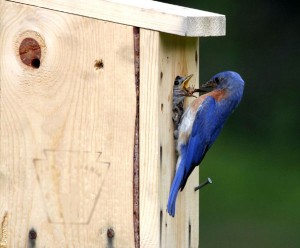Audubon Society Responds To Magazine Writer
 The Bermuda Audubon Society has responded to a “Scientific American” writer who said genetic research which suggests the island’s threatened bluebird population is only 400 years old means “they shouldn’t be major priorities” for conservationists.
The Bermuda Audubon Society has responded to a “Scientific American” writer who said genetic research which suggests the island’s threatened bluebird population is only 400 years old means “they shouldn’t be major priorities” for conservationists.
Research conducted at Rutgers University and published in the scientific journal “Molecular Ecology” found Bermuda’s bluebirds are not a native species as had long been thought but were probably introduced shortly after the arrival of the first permanent settlers in 1612.
Writing at the “Scientific American’s” webpage, natural history correspondent Hannah Waters said on Monday [Apr. 8]: “Whether the bluebirds are native or invasive isn’t the real question at hand, but whether they are unique enough in the world that they deserve extra conservation protection.
“They are not unique from other bluebirds, according to these new findings, and if a conservation organisation, for example, is trying to direct funding to preserve unique species, these bluebirds shouldn’t be major priorities.”
The Audubon Society responded with a statement today [Apr. 11], saying: “The argument then seems to be that if they are not native they should not be valued or protected. There is in fact no formal scientific consensus on what constitutes a native species, but the generally accepted definition depends on whether or not humans were involved in its introduction to an environment and the length of time the organism has been there.
“There is no evidence to suggest that bluebirds were introduced to Bermuda by man; the research concludes that it may just as possibly have been ‘a one-time founding of migratory individuals that remained on the island to breed’. So if bluebirds may have found their own way to the island and have been breeding here for 400 years, they can in fact still be defined as native.
“… The Bermuda Audubon Society will continue to promote the use of nest-boxes to ensure that our local bluebirds continue to survive on the island.”
The full statement follows below.
Why We Should Protect Bermuda’s Bluebirds:
“The genetic study referred to in the article was supported and partially funded by the Bermuda Audubon Society. The findings of the study — which suggests that Bermuda’s bluebird population is relatively young and may date back to the early 1600s, coinciding with human settlement — is of great interest scientifically, but should not affect the way in which we value these birds locally, nor whether or not they deserve protection.
“This mis-interpretation of the research seems to have arisen from an article in ‘Scientific American’ which makes much of the fact that, since bluebirds were probably not found in Bermuda prior to human settlement, they should not be regarded as a ‘native’ species.
“The argument then seems to be that if they are not native they should not be valued or protected. There is in fact no formal scientific consensus on what constitutes a native species, but the generally accepted definition depends on whether or not humans were involved in its introduction to an environment and the length of time the organism has been there.
“There is no evidence to suggest that bluebirds were introduced to Bermuda by man; the research concludes that it may just as possibly have been ‘a one-time founding of migratory individuals that remained on the island to breed’. So if bluebirds may have found their own way to the island and have been breeding here for 400 years, they can in fact still be defined as native.
“Because Bermuda’s bluebirds are a slightly different blue from those in the eastern states of North America (the only other place they are found), there has long been some question over whether they may be a unique sub-species. The Bermuda Audubon Society supported this research to establish whether or not that was the case. The findings show that while there is limited genetic variation between our island birds and the North American birds, there ‘has been sufficient divergence in morphology [colouration] to be classified as a sub-species’.So whether or not our local Bluebirds are defined as native, they are none-the-less unique.
“Furthermore, bluebirds can in no way be termed ‘invasive’. They are not a threat to Bermuda’s native and endemic biodiversity, and in fact are a beneficial bird to have on the island as they are insect-eaters. Farmers and gardeners both appreciate the bluebirds’ presence as they eat the cut-worms, aphids and other pests that can damage crops and ornamental plants. They are also highly valued simply for their beauty –- not for nothing are they known as the bird of ‘happiness’. Yes, Kiskadees too are beautiful birds, but unlike Bluebirds they are aggressive invaders that will attack and kill other resident species of song-bird.”
“The population of local bluebirds is estimated at around 500 pairs.However, this is not a large population and it is entirely dependent on man-made nest-boxes. Ongoing loss of open space to development, competition from invasive species such as sparrows and starlings and a large feral cat population all present continued threats.
“The Bermuda Audubon Society will continue to promote the use of nest-boxes to ensure that our local bluebirds continue to survive on the island.”
-
Read More About
Category: All, Environment


Contrary to the,”research”our blue birds are extremely scarces on the Island and we should put them on, “a protective list” along with other protected birds…